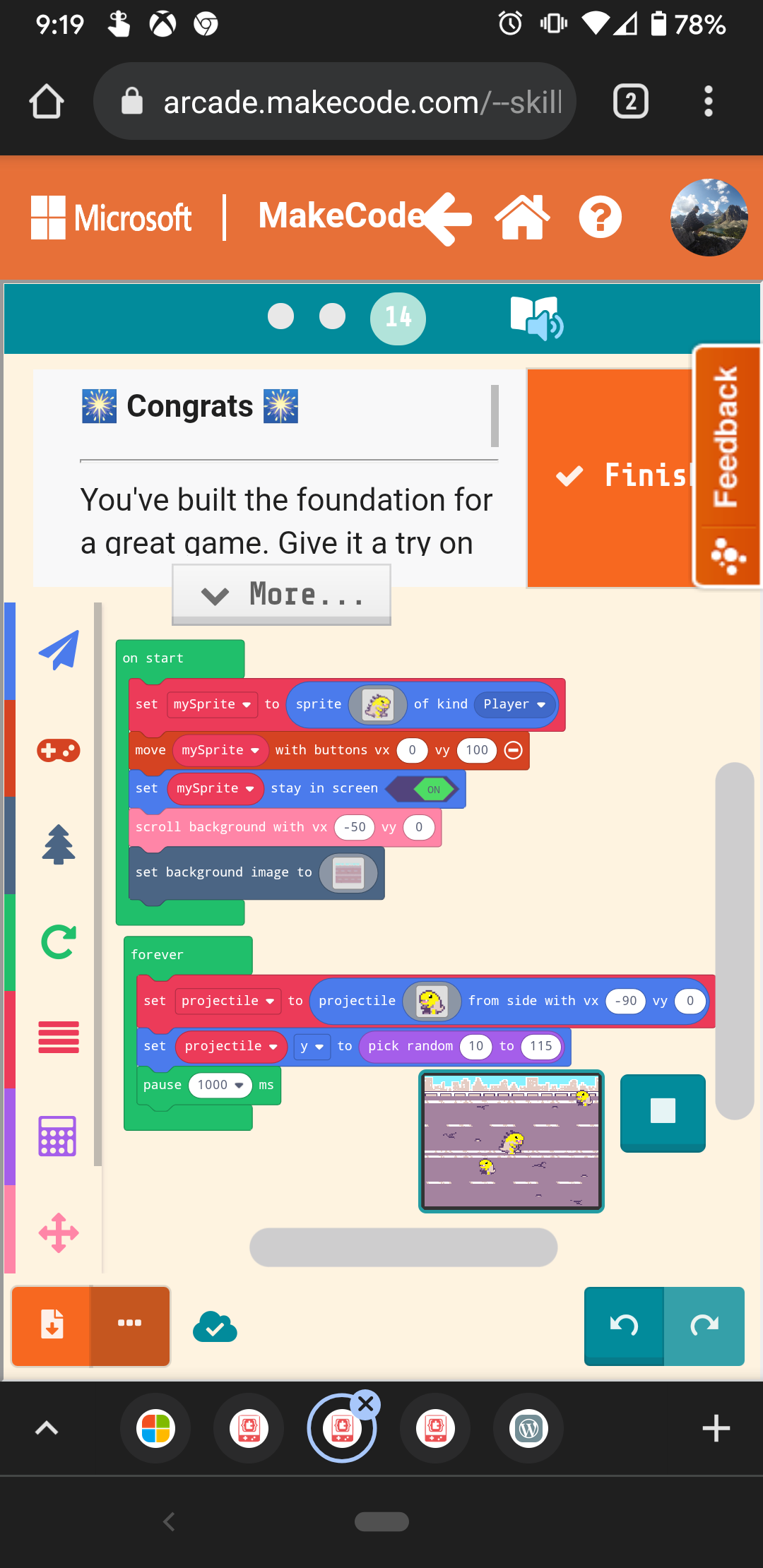
Since taking Games and Learning, I have found that game design projects are one of the most exciting and engaging avenues for students to share what they’re learning. Last year I began with Scratch-based games, and I was amazed at the variety of games students were able to develop, however, this always involved a degree of “suspended disbelief”; the cartoon sprites and backgrounds betray that this is but a child’s plaything, and not a “real game”. Makecode Arcade just might be the thing to change that, while not involving a prohibitively steep learning curve for a middle school context like other applications such as the Unity engine.
Makecode Arcade still involves coding with blocks, however, the output is a simulated gameboy-like virtual console complete with an appropriately pixelated screen. What’s more, the editor has been appropriately optimized for mobile devices, and while it can get congested with the block categories, workspace, instructions and output screen all sharing the space of a phone screen, I was able to navigate them successfully to create several simple games from the built in guide for newbies.
The great thing about game design is that in this day and age all students are gamers to some degree, and all students get excited at the prospect of emulating or creating a version of their own favorite game, and the cross-curricular applications are endless (math in movement/scoring, backstory telling, historical context, etc.). This is a platform that helps make the child’s version of game design a little more authentic while keeping teacher investment low given the step-by-step guides, and that makes it so much more worthwhile!
Check it out at the link below and remake your favourite classic game today!
https://arcade.makecode.com/#
Thanks for the link to MakeCode Arcade, Brendan. I ran first digital game design camp for kids in the summer, so am always on the look out for more kid friendly game design platforms.
Two comment of yours that I am curious about. The first, “cartoon sprites and backgrounds betray that this is but a child’s plaything, and not a ‘real game’”. This left me a bit at a loss, as many adult and all ages games utilize cartoons as well, including those created by adults. Rather than being subjective about the look, the questions that ring through my head are is this tool meeting my goals in encouraging digital game design in the classroom, what game design elements are missing in this tool, as the kids grow and want greater challenges and to be building towards creating on professional game engines, what other game design platforms will help to facilitate that?
In terms of your comment that, “The great thing about game design is that in this day and age all students are gamers to some degree.” This was true when we were kids too, and when our parent were kids. The new element here is the addition of digital games.
In case you are curious, the platform the kids and I predominantly used this past summer for our game design camp was Elementari, which is a interactive storytelling platform that I personally love. Here’s a link: https://elementari.com/
Hi Erica,
Thanks for your comment and the resource you shared, and you indeed raise some valuable critiques. In terms of the “cartoon sprites and background”, of course there are many adult games, TV shows and other forms of media that are based on cartoons, and I will concede this doesn’t not inherently make Scratch a child’s platform, however, I have found that for Middle years students, the user interface itself appears “child-like” from the bright colours, happy characters and warm environments. Scratch is actually the platform I have previously been the most successful with and I appreciate how effectively it employs similar language to text-based programming languages so that students can transition to them when they are ready; my struggle has been that I haven’t yet found an effective intermediary step between block-based on text-based programming yet (perhaps blocks that require more specific syntax?).
Your point about gaming across the generations is of course correct; my comment was more concerning digital gamers specifically.
Hello Brendan,
Thank you for raising coding. Since I am interested in learning how to code, and the tutorial will be helpful. Nevertheless, I believe that code literacy is the literacy that needs to be introduced in classrooms. And Gamification is an excellent approach since it is engaging. Students have the opportunity to learn and will enjoy the experience. As you mentioned, they have the option to design a version of their game. Coding literacy should be introduced in K-12 classrooms.